
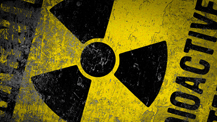
FUKUSHIMA NEWS
~ ~ ~ ~ ~ ~ ~
Help the
NO NUKES Y'ALL
campaign
y'all
Nuclear Watch South is a 501(c)(3) tax-deductible charitable organization.
{ thanks }
PayPal
It's your
safe and secure
way to donate on-line
 |
~ ~ ~ ~ ~ ~ ~

Educating and activating the grassroots to create a
nuclear-free future
~
PO Box 8574
Atlanta, GA 31106
404-378-4263
Cell 404-432-8727
info@nonukesyall.org
NO NUKES Y'ALL!
PLUTONIUM | PLUTONIUM
HISTORIC PUBLIC REFERENDUM
ON NUCLEAR WEAPONS
 RARE OPPORTUNITY
RARE OPPORTUNITY
TO SPEAK
TRUTH TO POWER
DEADLINE FOR PUBLIC COMMENT on the scope of the Plutonium Pit Programmatic Environmental Impact Statement
JULY 14, 2025
PLANET EARTH 7/14/25: NEPA, the National Environmental Policy Act, enacted in 1969, requires analysis of all foreseeable environmental impacts of a proposed project. In this case, the proposed project is a Plutonium Pit Factory at the Savannah River Site to build the explosive radioactive triggers for nuclear weapons. The NEPA PEIS process (Programmatic Environmental Impact Statement) mandates seeking and including public input to establish the scope of the project, and subsequent public comment on the draft PEIS prior to undertaking the project.
NEPA provides a powerful opportunity for the public to address the dilemma of nuclear weapons, upon which the U.S. is currently lavishing $100,000 per minute.
YOUR COMMENTS NEEDED!
NEPA law requires that the PEIS analyze ALL environmental, social justice and economic aspects of plutonium pit production. It also requires analysis of alternatives to the proposed action.
Nuclear Watch South has crafted the following statement which you are welcome to copy and send. Email your comment to PitPEIS@nnsa.doe.gov and give it a good title!
Scroll down for more background and for links to other comments you may wish to study, copy, adapt and send. Please take advantage of this golden opportunity to express your opposition to nuclear weapons in a forum where the law demands that the government listen and respond!
Email your comment to:
PitPEIS@nnsa.doe.gov
Copy, paste and edit as you wish. Don't forget to sign your comment and include the city and state where you live.:
To Ms. Jade Fortiner, NEPA Document Manager,
I am submitting these comments to NNSA's Programmatic Environmental Impact Statement for Plutonium Pit Production:
NEPA requires NNSA to analyze all foreseeable impacts of producing plutonium pits. Therefore, deployment of the atomic bombs which will utilize the plutonium pits must be analyzed in the PEIS. Since atomic weapons are the most destructive force created by mankind, annihilating living environments by design, they cannot possibly be permitted under NEPA.
There is plenty of hard evidence upon which to base the environmental impacts of plutonium. Examine Trinity downwinders with cancer in Tularosa, NM. Examine survivors in Nagasaki, Japan, who were ravaged by Fat Man. Sacred Western Shoshone tribal lands are scarred and contaminated from testing plutonium bombs. In our country's worst "broken arrow," a B52 bomber crashed losing four plutonium bombs in Palomares, Spain. Areas are still restricted since the 1966 catastrophe. U.S. soldiers dug up plutonium-contaminated soil filling 8,000 barrels which were transported to Savannah River Site in South Carolina for shallow burial.
Significant to this PEIS is the plutonium pit production experience at Rocky Flats in Colorado, which was raided by the FBI and shutdown in 1989 after a series of fires, explosions, and deliberate contamination. Following the FBI raid there were shocking revelations about the contamination and radioactive waste stored at Hanford and Savannah River Site where the plutonium used at Rocky Flats was created in nuclear reactors and separated for atom bombs. Since the FBI raid, DOE has attempted, first in 1991 with "Complex 21," then again in 2008 as "Complex Transformation," to site a plutonium pit production factory at SRS. The citizens who commented in these EIS processes resoundingly rejected plutonium pit production at SRS.
DOE/NNSA is back for its third attempt with the $1.5 trillion "Nuclear Modernization Program" and the proposal to build-out the unfinished MOX factory at SRS for plutonium pit production. The writers of the PEIS should be required to read The Ambushed Grand Jury: How the Justice Department Covered Up Government Nuclear Crime: And How We Caught Them Red Handed by Wes McKinley and Caron Balkany and Full Body Burden: Growing Up in the Nuclear Shadow of Rocky Flats by Kristen Iversen. I wish to incorporate both texts by reference into these comments.
It is unacceptable under NEPA to produce atomic bombs and plutonium triggers because of their inherent destructive natures and SRS is a particularly unsuitable place for the poisonous plutonium enterprise. SRS is situated on the banks of the Savannah River, a major river in the Atlantic Seaboard and the boundary between Georgia and South Carolina. The Savannah River empties into the Atlantic Ocean 200 miles downstream from SRS where a rich and fragile ecosystem supports millions of birds, alligators, sea turtles, oysters, shrimp, gopher tortoises, and so many creatures. The PEIS must account for them. The Georgia/South Carolina coast is where the critically endangered North Atlantic right whale migrates annually to give birth and nurture newborn calves. The Savannah River supports a diverse ecology while serving agriculture and industry and providing drinking water for 1,000,000 people downstream from SRS and is a major transportation route. The Savannah River is currently ranked as the nation's third most polluted waterway and it should be protected under NEPA from further injury from plutonium pit manufacture.
NEPA also requires analysis of alternatives to the proposed action. Nuclear disarmament is the natural, logical alternative to building new nuclear weapons and is an urgent mission which will enhance national and global security. Nuclear disarmament poses a scientific challenge that will require breakthroughs in research and technology to manage the fissile materials, radioactive waste, contaminated buildings, and land which are the lethal legacy of the Atomic Age. Remediating the harm from decades of producing weapons of mass destruction will take a Manhattan Project-level commitment equal to the effort made to develop nuclear weapons 80 years ago.
The U.S. has 90 tons of weapons-grade plutonium of which 45 tons is already recognized as excess. The U.S. has 67,800 tons of uranium of which 600 tons is weapons-grade. These fissile radioactive elements have radioactive lifespans which defy human comprehension and must be appropriately managed and safeguarded if life is to continue on our home planet.
The U.S. has more than 5,000 nuclear weapons to dismantle. There are 35,000,000 gallons of high-level radioactive liquid waste in Cold War-era underground tanks at SRS. There are 56,000,000 gallons of tank waste currently stranded at Hanford. These wastes were generated to produce the U.S. inventory of plutonium and it is urgent that they be managed and contained. The one possible saving grace of the lack of progress in vitrifying these radioactive tank wastes into glass for deep geologic burial is the potential to immobilize plutonium in the waste vitrification process. The high radiation in the tank wastes will create a lethal barrier to plutonium being recovered and diverted to nuclear weapons again in the future. The concept of plutonium immobilization was considered in the MOX PEIS and it should be reconsidered in the PEIS for Plutonium Pits.
The PEIS analysis of the vital nuclear disarmament mission will provide a blueprint to establish the amount of time, money and personnel that will be needed to close the circle on the splitting of the atom. The U.S. led the world into the Atomic Age and it is a noble and just mission to lead the world to nuclear disarmament.
We have a good start towards nuclear disarmament as we have not produced nor tested nuclear weapons for more than 30 years. Global support for nuclear disarmament is expressed in the U.N. Treaty on the Prohibition of Nuclear Weapons which entered into force of law in 2021, signed by 122 nations and ratified by 73 state governments. Despite these achievements, the U.S. is still spending over $100,000 per minute on nuclear weapons, more than all other nuclear-armed nations combined. With that kind of money, we can surely accomplish the great work of dismantling nuclear weapons.
I am grateful to the National Environmental Policy Act and to NNSA for giving the public a voice on the life-and-death matter of nuclear weapons. I am grateful to the South Carolina Environmental Law Project which represented SRS Watch, Nuclear Watch New Mexico, Tri-Valley CAREs and the Gullah/Geechee Sea Island Coalition to protect our right to be heard and to have our comments recorded for history.
Please include me on the PEIS distribution list.
Respectfully submitted,
(please sign your name and include city and state)
You are encouraged to personalize your statement. There are links to other groups' comments below. You may wish to simply state the obvious: that nuclear war threatens every thing on our home planet. Every child, mother, father. Every creature great and small. Every body of living water. Every tree and flower, fruit and vegetable. Speak for who and what you most cherish and wish to protect from nuclear annihilation!
BACKGROUND In 1989, the FBI raided and permanently shut Rocky Flats, the only U.S. factory which made plutonium pits, AKA triggers, for nuclear weapons. Rocky Flats had operated near Denver for decades, contaminating the Colorado countryside with plutonium and other radioactive elements which escaped through fires, explosions, accidents and on purpose. The contractor, Rockwell International, received record fines and a grand jury sought to indict eight corporate and government executives for criminal wrongdoing.
Revelations about widespread contamination and leaking radioactive waste tanks throughout the U.S. nuclear weapons manufacturing complex followed the shutdown of Rocky Flats and by 1991, the U.S. had shuttered almost all of its crumbling nuclear factories. The U.S.S.R. collapsed and a brief promise of a "peace dividend" and nuclear clean-up soon evaporated as U.S. nuclear weapons contractors such as Lockheed, Boeing, Raytheon and Honeywell circled the wagons and continue to this day to perpetrate a U.S.-driven global nuclear arms race. Since the closure of Rocky Flats, two failed attempts have been made to site a plutonium pit factory at SRS, (Savannah River Site) on Georgia's border in South Carolina.
NOW THEY'RE B-A-A-C-K The U.S. National Nuclear Security Agency (NNSA) is attempting for the 3rd time to conduct plutonium pit manufacturing at SRS, proposing to convert the unfinished MOX plutonium fuel factory to a plutonium pit production factory. This public referendum we are offered is a direct result of a successful legal challenge by South Carolina Environmental Law Project on behalf of SRS Watch, Nuclear Watch New Mexico, Tri-Valley CAREs, and Gullah/Geechee Sea Island Coalition. The importance of this victory is that it forces NNSA to perform a full PEIS (Programmatic Environmental Impact Statement), to vigorously seek public input and subsequently respond to that input instead of the much weaker Environmental Assessment the agency planned to produce. It is important to note that the national nuclear weapons production complex was created in secrecy almost a century ago and operated for decades with no oversight. Now, thanks to NEPA the U.S. cannot build its nuclear weapons manufacturing capability back up without public dialogue. Another important note to make is that the U.S. has not manufactured or tested nuclear weapons for more than 30 years. Momentum is with nuclear disarmament! Together we can stop the new nuclear arms race!
LINKS FOR TALKING POINTS
SRS WATCH
UNION OF CONCERNED SCIENTISTS
NUCLEAR WATCH NEW MEXICO
TRI-VALLEY CARES
DOWNLOAD
FEDERAL REGISTER NOTICE
DOWNLOAD NUCLEAR WATCH SOUTH COMMENTS
Email your comment by midnight 7/14/25 to:
PitPEIS@nnsa.doe.gov
PLUTONIUM ~ Toxic Brain-Child of the Nuclear Age
PLUTONIUM is a man-made element — the result of fissioning uranium in a nuclear reactor. It is a long-lived, radioactive, heavy metal named after the Roman god of the underworld and is hellishly toxic if the plutonium oxide powder is inhaled.
With less than 15 pounds of plutonium and plans that can be found on the internet, virtually anyone can make a nuclear bomb the size of that which ravaged the city of Nagasaki, Japan, at the end of World War II. There are 100s of tons of plutonium on Earth, in nuclear weapons and in storage. Over 90 tons was made by the United States. It is a huge security challenge to keep plutonium under lock and key for its hazardous and fissionable life-span. Plutonium, thermonuclear weapons, nuclear energy, and radioactive wastes present our society with challenges that lie far outside previous human experience.
PLUTONIUM, PLUTONIUM EVERYWHERE
Plutonium for nuclear weapons was manufactured in five reactors at Savannah River Site (SRS) in Aiken, S.C., and also at Hanford in Washington State. Plutonium was separated out of the irradiated nuclear reactor fuel by chopping the hot radioactive spent fuel into little pieces and then dissolving it in industrial solvents. The separated plutonium was transported to nuclear weapons labs and manufacturing sites all over the country.
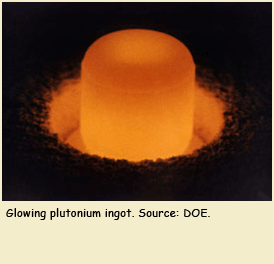 Left behind at SRS were 35,000,000 gallons of liquid hazardous radioactive wastes which are still being kept in underground tanks 20 years after plutonium production stopped. The liquid wastes are contaminated with lethal, highly radioactive elements such as cesium 137 and cobalt 60. The 50-year-old tanks are beginning to leak and threaten to contaminate the largest freshwater aquifer recharge area in North America.
Left behind at SRS were 35,000,000 gallons of liquid hazardous radioactive wastes which are still being kept in underground tanks 20 years after plutonium production stopped. The liquid wastes are contaminated with lethal, highly radioactive elements such as cesium 137 and cobalt 60. The 50-year-old tanks are beginning to leak and threaten to contaminate the largest freshwater aquifer recharge area in North America.
Graphite-like plutonium oxide powder was transported to Rocky Flats in Denver, Colorado, to be alloyed into metal and made into nuclear warhead triggers, called plutonium pits. The FBI and EPA raided Rocky Flats in 1989 and permanently shut the national U.S. plutonium trigger factory after an investigation and trial which resulted in jailed jurors and millions of dollars in fines paid by contractor Rockwell International. As part of Rocky Flats "clean-up," several tons of leftover scrap plutonium were transported across the country to SRS despite the South Carolina governor's legal efforts to keep it out of his state.
Grapefruit-sized plutonium pits made at Rocky Flats were sent to Pantex in Amarillo, Texas, to be placed into nuclear warheads at the assembly factory there. Many thousands of plutonium triggers are deployed in U.S. nuclear weapons on Trident submarines and at various missile silos and depots. More than 20 tons of "surplus" plutonium pits, enough to arm literally thousands of nuclear warheads, sit on warehouse shelves at Pantex and pose a long-term security risk.
PLUTONIUM IS FOREVER
Plutonium does not occur in nature and there is no "natural" state to which we can return it. Plutonium is extremely toxic and bonds with lung tissue if inhaled, eventually causing lung cancer. Plutonium can catch fire when exposed to air.
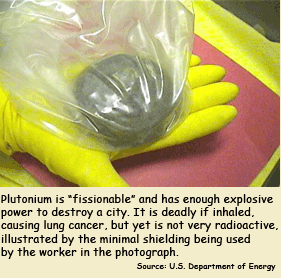 Plutonium has an unimaginably long half-life — 24,600 years — and its hazardous life is 10 times as long. Humans have only been recording history for around 5,000 years — how will we secure this breathtakingly dangerous weaponized heavy metal, a human-created Frankenstein monster born less than one human lifetime ago?
Plutonium has an unimaginably long half-life — 24,600 years — and its hazardous life is 10 times as long. Humans have only been recording history for around 5,000 years — how will we secure this breathtakingly dangerous weaponized heavy metal, a human-created Frankenstein monster born less than one human lifetime ago?
Despite plutonium's toxicity and thermonuclear explosive capacity, plutonium is not very radioactive and therein lies its vulnerability to theft. That is why, to secure the plutonium from being used in weapons for a long, long time, it is desirable to make it "self-protecting" by emplacing it in a highly radioactive medium such as that proposed with PLUTONIUM IMMOBILIZATION or the controversial MOX plutonium reactor fuel program at SRS.
NUCLEAR REACTORS AND PLUTONIUM
Every nuclear reactor makes plutonium when it is operating including commercial reactors which make electricity. Irradiated commercial reactor fuel is notoriously radioactive which is why the 1984 Nuclear Waste Policy Act requires that it be isolated from the environment forever in a deep geologic repository. Yucca Mountain was the controversial candidate to host the nation's waste repository but funding for it has been cancelled and its license application is being withdrawn.
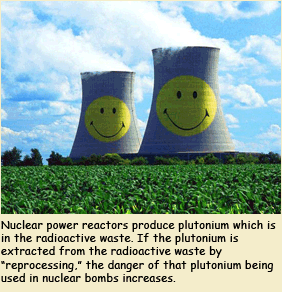 The failure of Yucca Mountain has emboldened the flagging nuclear industry to propose once again a dangerous practice called nuclear waste "reprocessing." Reprocessing uses the process outlined above which has already stranded millions of gallons of radioactive waste at SRS, and would likewise produce more radioactive waste in addition to plutonium, the essential ingredient in nuclear bombs.
The failure of Yucca Mountain has emboldened the flagging nuclear industry to propose once again a dangerous practice called nuclear waste "reprocessing." Reprocessing uses the process outlined above which has already stranded millions of gallons of radioactive waste at SRS, and would likewise produce more radioactive waste in addition to plutonium, the essential ingredient in nuclear bombs.
In the reprocessing scheme of things, a new type of reactor fuel, called MOX, would be made from the plutonium. Reactors which are only conceptual at the present time would be required to use the plutonium fuel (which would then require deep geologic disposal once irradiated). The ambitious reprocessing scheme would take 20 years and untold billions of tax dollars to achieve, and would greatly worsen the quandaries already presented by both plutonium security and radioactive waste management. Human experience with reprocessing has been disastrous for the environment in every instance and yet it is under serious discussion and SRS is the favored host site.
Radioactive waste from commercial nuclear reactors is truly a dilemma for which there is no satisfactory solution. It should be studied with the intensity brought to the discovery of plutonium and designing and manufacturing nuclear reactors and weapons. Until a permanent repository is created, environmentalists advocate keeping radioactive waste at the generating site.
~ ~ ~ ~ ~
Nightmare or Dream?
“Plutonium is a physicist’s dream but an engineer’s nightmare. With little provocation, the metal changes its density by as much as 25 percent. It can be brittle as glass or as malleable as aluminum; it expands when it solidifies, much like water freezing to ice ... it is highly reactive in air ... plutonium damages materials on contact and is therefore difficult to handle, store, or transport. Only physicists would ever dream of making and using such a material. And they did make it — in order to take advantage of the extraordinary nuclear properties of plutonium-239.”
Plutonium, An Element at
Odds with Itself. Los Alamos Science. 2000.
Number 26.
excerpted also from PLUTONIUM: THE LAST FIVE YEARS by Don Moniak.
~ ~ ~ ~ ~
Both the planet Pluto and the element plutonium are named for the ancient god Pluto, ruler of the underworld
and the dead. In mythology, Pluto was an unwelcome visitor to Earth and to the ancient abode
of the gods Olympus, because of his unpitying and inflexible nature. Pluto was King of the Dead, but not Death itself; terrible, but not evil.
"To the village square
we must carry the facts
of atomic energy.
From there must come America's voice."
ALBERT EINSTEIN
~~~~~~
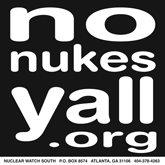
~~~~~~
THE WORKERS,
THE WASTE,
AND THE WARNINGS
FROM BOMB COUNTRY
From South Carolina
to California,
locals in nuclear weapons towns raise health, safety, and environmental concerns over renewed plutonium
pit manufacturing.
by Taylor Barnes
InkStick Media
6/12/25
~~~~~~
MORE ON PLUTONIUM
It's Time to Pull the
Plug on the MOX "Factory to Nowhere"
by Ed Lyman
PLUTONIUM WAITS
Glenn Carroll
JUST CAN IT
Edwin S. Lyman, Ph.D.
PLUTONIUM END GAME
Arjun Makhijani, Ph.D.
PLUTONIUM:
THE LAST FIVE YEARS
Don Moniak
RADIOACTIVE WASTES AND THE GLOBAL NUCLEAR ENERGY PARTNERSHIP
Robert Alvarez
ANA MOX FACTS
GREENPEACE
PLUTONIUM FACTS
MORE GREENPEACE PLUTONIUM
~~~~~~
PLUTONIUM FACTS
Year plutonium was discovered by Glenn Seaborg and others
1941
Minimum amount of plutonium required for bomb
1 kilogram (2.2 pounds)
Amount of plutonium used in Nagasaki bomb
6.5 kilograms
Average amount of plutonium used in modern atom bomb
3 kilograms
Estimated amount of U.S. weapons-grade plutonium
85,000 kilograms (93.5 tons)
Estimated amount of Russian weapons-grade plutonium
160,000 kilograms (176 tons)
Hazards associated with plutonium
Radiation, fire, inhalation, ingestion, criticality, reactivity, decay
Length of time that
plutonium 239 (weapons-grade) remains hazardous
240,000 years
(Ten 24,000-year half-lives)
Form of plutonium most hazardous to life
Plutonium oxide powder
What happens to plutonium metal when exposed to air
Gradually turns to
plutonium oxide powder
Lethal amount of plutonium oxide powder (inhaled)
2000 micrograms
Lethal amount of plutonium oxide powder (ingested)
500,000 micrograms
Amount of sugar substitute in average 1 gram package
1,000,000 micrograms
Excerpted from Stop Plutonium Fuel: Plutonium Index, compiled by Don Moniak. Blue Ridge Environmental Defense League, www.bredl.org
